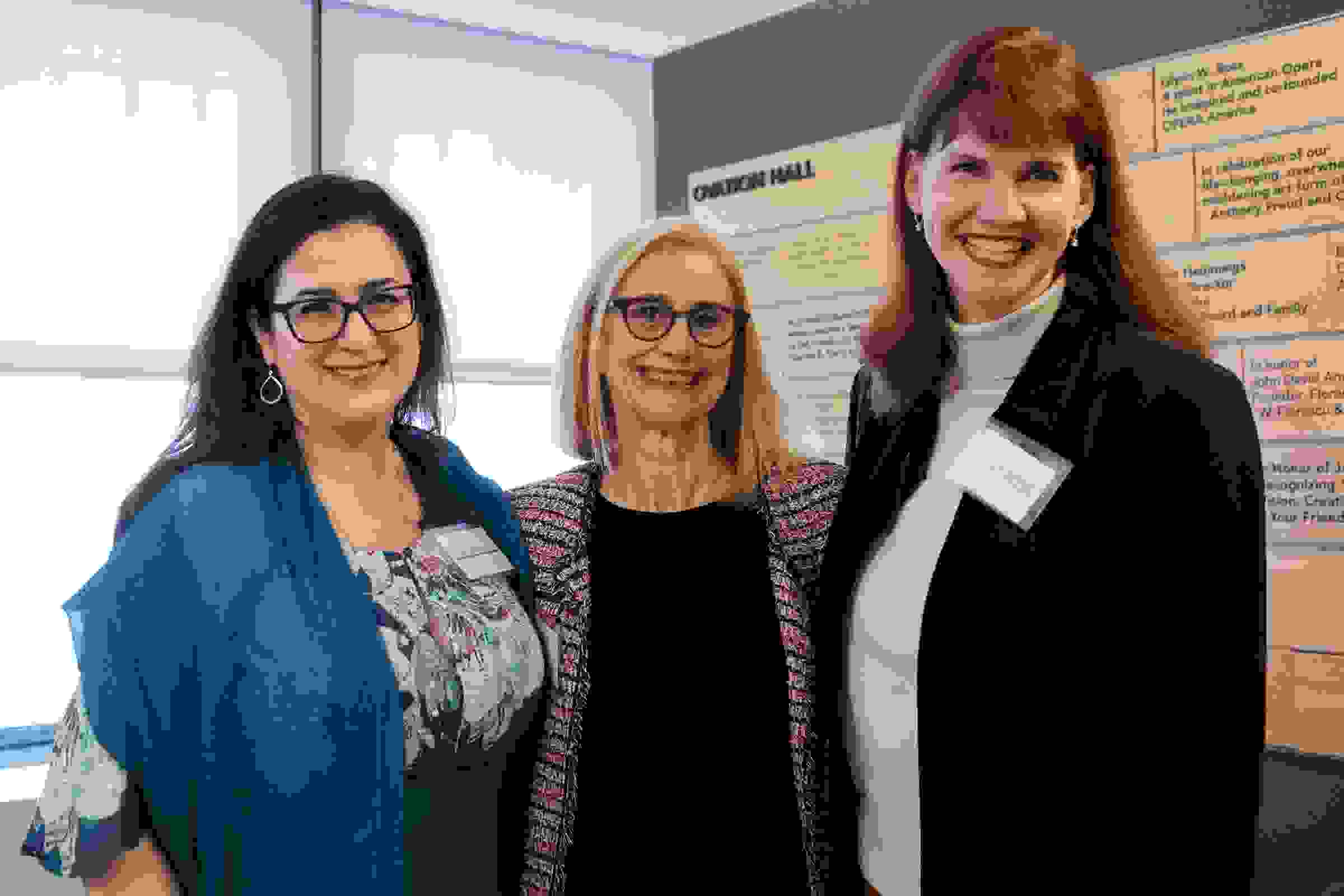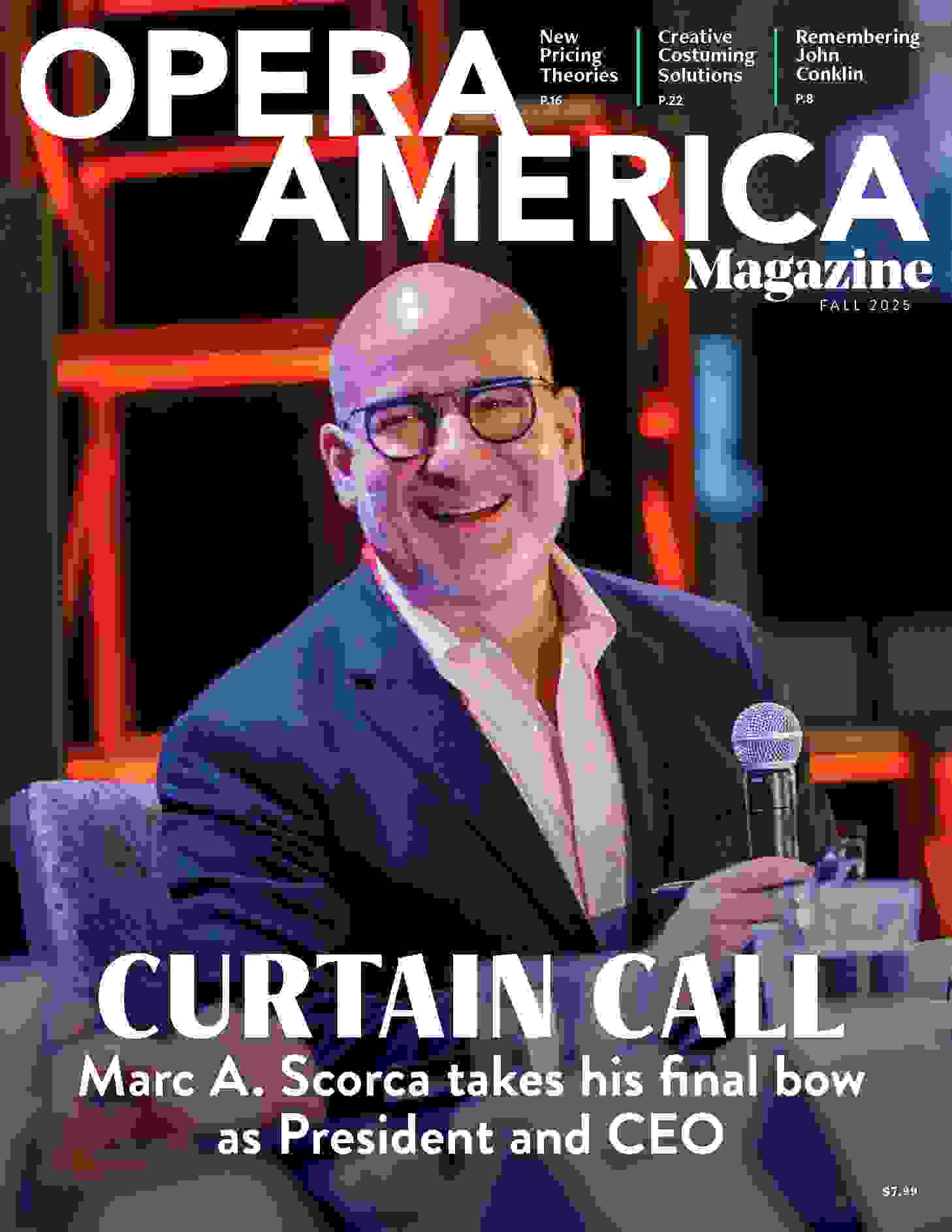Mentor & Protégée
Stacy Brightman and Mitra Sadeghpour — one of the inaugural teams in OA’s Mentorship Program for Women — discuss their shared challenges and opportunities.
OPERA America’s Mentorship Program for Women teams emerging female administrators with established leaders. At the 2019 Backstage Brunch at the National Opera Center, career coach Astrid Baumgardner led a discussion with one of the initial pairs of participants: Stacy Brightman, vice president of education and community engagement at LA Opera, and Mitra Sadeghpour, who was recently appointed education director at Minnesota Opera after being director of opera at the University of Northern Iowa.

ASTRID BAUMGARDNER: We’ve all heard about the Mentorship Program for Women, and now we’re going to find out what really went on in that first year. Before we get into details, I’d like you both to describe your career trajectories. Mitra?
MITRA SADEGHPOUR: I’m a farm girl. I grew up in Martelle, Iowa, a town of 238 people. It was a place like in Aaron Copland’s The Tender Land: I remember looking out at the horizon and thinking, “What’s out there?” The town valued football, but my family valued education. My mom was a science teacher, and she nurtured young women to go on in science. That part of Iowa is filled with Department of Natural Resources officers, and a lot of them are women who got jobs in the sciences because of my mom. I went on to get all my degrees in performance, but I knew that I really wanted to be in education, mentoring women in this field.
BAUMGARDNER: Stacy, you come from a very different background.
STACY BRIGHTMAN: My childhood was almost the complete opposite. I grew up on Rampart Boulevard in the middle of Los Angeles. I had a single mother, and we had a very, very low income — let’s say it was poverty. My mother only got up to the ninth grade before she had to leave school, but she had this extraordinary understanding that if you can give a young person an education, but also a love and knowledge of the arts, it could open up the doors of the world — even if you lived in Los Angeles on Fourth and Rampart. She was a fierce master at figuring out every free thing we could do. It was a childhood spent taking the bus to free museum days. Where I get to work, at the Dorothy Chandler Pavilion, I think about how we would sit for $7.50 in the very last row of the balcony — we were practically in Nevada! But if you could walk into that building and feel like you belong there, then you could walk into any place in the world.
BAUMGARDNER: You had mentors in school and in your professional career, no?
BRIGHTMAN: I did, men and women. What they had in common was that they saw something in me that I didn’t see in myself. They’d say, “Try for the better school; try for that program; throw your application in for that job.” They didn’t leave me a choice: They had become stakeholders in my life.
BAUMGARDNER: Mitra, what challenges did you face as you created your career path?
SADEGHPOUR: When I started my career as a singer, it didn’t really occur to me that there wasn’t gender parity. You’re competing against all sopranos, right? Even applying for teaching positions, it’s against other sopranos. But then you get the job and see that everyone whom you report to — your dean and the chief academic officer and the president of your university — is male. And that can be wonderful: Being a male is not essentially a problem! But as I got older and more experienced, I started to see that there was a barrier to getting in the door for jobs that are usually held by men. That’s changing a lot now.
BRIGHTMAN: My experience has been that a woman will get the job done. Somebody left a mess on the stage and it’s not ready for the rehearsal? Well, grab a broom, ladies — we’re the ones who are cleaning it up. We’re not afraid of doing what is needed, maybe because our egos are malleable. But that has served me well in the nonprofit world. The grant proposal needs to get done? “Okay. I’ll do it. I can stay late. No problem.” Auditions need to be scheduled? Somebody needs to negotiate the contract with the union? “Okay, I’ll do it. Sure.” What an astonishing set of learning opportunities, and for me it was rooted in being a female. I’m used to just doing whatever needs to get done to close the loop, to make sure that things happen, to make sure that my kids get their homework done and get off to school, that lunches get made, that dishes get done — and that the show gets onstage.
BAUMGARDNER: So you both had very interesting experiences in the professional world that you would now bring to this mentoring relationship. Let’s just pause and talk about that. The philosophy here was that this is a teaching relationship — that the mentor facilitates the learning of the protégée. Stacy, what attracted you to being a mentor?
BRIGHTMAN: It was absolutely about honoring what people along the way have done for me. It felt like paying your taxes. You have been given so much; you have to give back. I felt it would be an honor to do this. Also, we’re in a creative industry, and the essential nature of what we do is to take risks. And so it’s good to put yourself in situations where you say, “Oh, this is interesting. That’s a little scary.” It was an exciting opportunity. The classic adage, that the teacher learns more than the student — that was certainly the truth.
BAUMGARDNER: And what about you, Mitra? What was your goal in entering this program?
SADEGHPOUR: Well, I felt that I might have been a long shot to apply. I think I was probably the only person from academia who did. I have been in the academy for 19 years, and while I’ve really loved it, I was starting to feel that I might want to change my focus and start working in the community. I became really interested in education and community engagement at the professional opera company level. But I wondered, “How do I bridge the gap from academia?” I know opera production, I know education, I know how to write a lesson plan, I know how to do learning goals. But there’s so much else that is so different from the academy in the professional world. And I needed help negotiating that and also knowing whether it would be right for me to do it. I had seen Stacy speak at the National Opera Association, where she said that everybody has the fundamental right to beauty. Everybody.
BRIGHTMAN: It’s true, it’s a basic human right to engage with art and beauty; it’s right there in the United Nations’ Declaration of Human Rights.
SADEGHPOUR: I thought: “How can I bring this wonderful art form, which has given so much to me and to my students, to everybody? That’s what I wanted, and that’s what I got with this master here.
BAUMGARDNER: It’s so interesting that someone from inner-city LA and someone from rural Iowa were able to create this amazing bond.
SADEGHPOUR: We clicked.
BAUMGARDNER: How did that happen?
BRIGHTMAN: OPERA America gave us a really good checklist, but we had to fill it in. What are going to be our shared goals? How are we going to achieve the goals? Every Wednesday afternoon we would Skype. Sometimes I was calling from my car; sometimes she was running between classrooms or to rehearsal. Very early on we decided that Mitra should spend a week in Los Angeles when we were producing our giant annual community opera at our cathedral.
SADEGHPOUR: It’s incredible.
BRIGHTMAN: I got to have her really see the community partnership work we do in depth. She met with our president and our marketing person. She got to make the whole circuit of the leadership at LA Opera. She met with a bunch of our different community partners to hear their views on why would they would want to work with an opera company. Then, thanks to a lot of the folks here in the room, essentially we plotted out the North American tour of Mitra Sadeghpour. She went from place to place to be a resident.
SADEGHPOUR: I think I was a week at the Chicago Lyric and a week at Houston and a week at the Met Guild. And then a lot of the rest of them were shorter. As an academic, I had my summer off, so I was able to do that.
BRIGHTMAN: It was amazing that OPERA America made this grant possible, but there was an awful lot of sleeping on people’s couches, as the best people do. A phone call or a Skype is great, but really our art form is person to person. It’s about the acoustic experience, breathing the same air and the soundwaves going through you. So I made sure that Mitra got to break bread with these critical people, creating a network for her that was personal and real. It’s a great challenge in our field, where I think that only about 20 people in the country have my job title. I wanted her to meet those 20 people.
SADEGHPOUR: It’s been the best year of my life in many ways. I felt my artistic soul was replenished. I was really struck by all the women in education, but the men, too, who were completely open with everything they were doing. They weren’t guarding secrets; they wanted to help.
BRIGHTMAN: The way I structured it came out of humility. I thought, “Gosh, I don’t know that I’m the person to represent the field.” So we all ended up mentoring Mitra, which was lovely. It’s corny but — it took a village.
This article was published in the Summer 2019 issue of Opera America Magazine.






